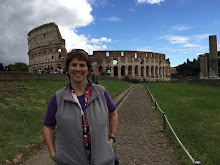Well, I'm a few years off, but I finally read it, and am annoyed with myself for waiting so long to finally get to it. I love reading historical fiction that teaches me something I didn't know anything about before i picked up the book. In this case, it's all about the Dutch pottery industry in the 1650's. Add that to a soap opera worthy story with a smart, capable lead female character, and this was a thoroughly enjoyable read.
Catrin has just lost her husband to a sudden illness, and she is a widow at 25. She decides to sell the farm, leave her small village, and makes her way to Amsterdam and a new life. There, she has a chance to learn a bit more about painting-something she loved to do on bits of furniture and pottery, but was never able to fully explore. Just when it looks like Catrin is settled into her job as housekeeper, her past comes back to haunt her, and she flees to the small city of Delft, where she is hired on as a painter of pottery in a local workshop. Working with Evert, the owner of the workshop, Catrin helps to develop a new kind of pottery to rival the Chinese delicate porcelain that is all the rage, but increasingly impossible to import. Has Catrin finally found her place, and another chance at love and happiness?
Catrin--I liked her from the get-go. She's brave, she's smart, and she's talented. She's a good person, and tormented by the choices she made in order to save herself. Throughout most of the novel, she is always questioning whether or not she will be punished by God for her sin, or if it's possible for God to forgive a sin that she didn't regret committing. Jacob, a former farm employee of Catrin and her husband, keeps showing up like a bad penny, threatening to expose Catrin's awful secret. He's always the catalyst that keeps the novel moving along.
Catrin has a lot of great luck, and a lot of bad luck. But she keeps going, keeps moving forward. I found the descriptions of the pottery workshops to be very interesting, and the glimpses of Rembrandt, Vermeer and their art throughout the novel make this time period really come alive with color and vibrancy. It definitely was Holland's Golden Age.
I've got nothing negative to say about this novel. I was happy to read about a completely different time period, and a completely different artistic movement-something I was pretty unaware of before I picked up this book. And of course the plague makes an appearance, and I find that very timely, with all the news about the Coronavirus spreading all over the world.
Rating: 4/6 for a historic novel full of artists, larger than life characters, unrequited love, evil-doers, a fiesty heroine, and a fascinating look at the beginnings of the Delft Blue porcelain movement in 1650's Holland.
Available in paperback.



No comments :
Post a Comment